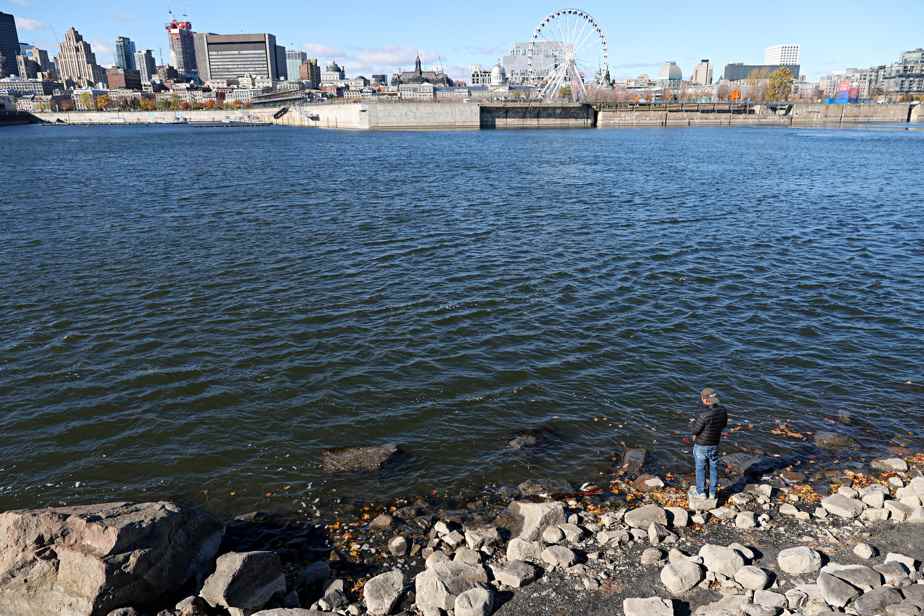The movement of goods is hampered by the lowest water levels in a decade on the St. Lawrence. A slimming regime is imposed on container ships and other vessels, which will drive up the price of metal boxes, in addition to eating into the income of other shipowners.
Posted at 6:00 a.m.
“It’s been a really below average year,” said Frank Seglenieks, co-chair of the International Lake Ontario and St. Lawrence River Board (CILO-FSL). We are keeping an eye on the water level in certain ports and other places that are affected. »
The reason ? Spring and summer dry weather. This prevented the St. Lawrence Seaway, this global trade route that connects the Great Lakes region, from returning to a level considered more usual. On average, the sills are 40 to 50 centimeters lower in some locations, says Seglenieks.
This has a direct impact on the draft, the submerged part of a boat which varies according to the load carried. Since this indicator is revised downwards, ship cargoes are lighter. One of the world’s largest shipping companies, Hapag-Lloyd, will pass the bill on to its customers.
As of next Tuesday, and until “further notice”, a surcharge of US$150 will be imposed for a “twenty-foot equivalent” container transiting through the Port of Montreal. The rate will double for a “forty foot equivalent”. These costs also vary according to the routes taken by the ships.

PHOTO FRANÇOIS ROY, THE PRESS
In places, the level of the St. Lawrence has never been so low in 10 years.
“The water levels of the St. Lawrence River have dropped considerably and the latest forecasts from the Canadian Coast Guard announce further drops,” explains the multinational, in a notice recently sent to its customers.
However, there is a consolation price for exporters and importers: the price of a metal can is around US$3,145 according to the World Container index, the international barometer in this area. This is 70% less than the average of US$10,377 seen in September 2021.
These additional fees decreed by shipping carriers are common in the industry, but this year they are imposed when the Council has not observed such low levels since 2012. The findings of the body responsible for monitoring the flow Lake Ontario and St. Lawrence River also come just weeks after the release of a national supply chain task force report that concluded the supply chain was approaching breaking point.
It’s not just in the St. Lawrence that the water is dropping. South of the border, the Mississippi sill recently hit an all-time low, which is also driving up shipping costs on this critical river artery. The same situation has been observed in Europe (the Rhine) as well as in China (the Yangtze).
A watchful eye
The Montreal Port Authority (MPA) says it is monitoring the St. Lawrence “very closely”, but there is no need to sound the alarm, says its director of communications, Renée Larouche.
“We’re in the lower middle range,” she said. We would prefer it to be a little higher, but we are not yet in a situation where we are worried. »
In the river, between Montreal and Quebec, the available water column is ideally maintained at 11.3 m or more. A water level approaching this threshold forces, among other things, maritime carriers to adapt, in particular by transporting less goods on each ship. On Thursday, the 30-day average level was 11.67m. However, there are several rights-of-way to measure the water level of the river, says Ms.me Larouche.
For shipowners using the Great Lakes, the permitted draft has been reduced since Monday between Montreal and Lake Ontario. Some companies are therefore forced to reduce the quantity of goods in their ships. This is particularly the case of Groupe Desgagné, whose fleet notably criss-crosses the Great Lakes-St. Lawrence Seaway network.

PHOTO ANDRÉ PICHETTE, LA PRESSE ARCHIVES
Groupe Desgagné vessels are not operating at maximum capacity due to the drop in water levels in the St. Lawrence.
“With a draft problem, you can load less, and it’s therefore less income, underlines the executive vice-president of operations and special projects, Claude Dumais. A 14,500 tonne ship, if it has to leave 500 tonnes on the quays, the capacity is not exploited to the maximum, but the operating costs remain the same for us. »
Fluctuations in water levels are “cyclical”, underlines Mr. Dumais, before adding that the phenomenon is “more pronounced” in 2022.
After sounding out its members, Louise Bédard, general manager of Armateurs du Saint-Laurent, says that the repercussions seem limited for the moment. However, the picture could change if precipitation is rare.
It will take several weeks before the situation resolves on the St. Lawrence. According to a recent bulletin from the St. Lawrence Seaway, “low water levels are forecast until the end of November”.
Learn more
-
- 40 million tons
- Total weight of goods that traveled through the St. Lawrence Seaway last year
St. Lawrence Seaway
- 15
- Number of locks to go through to get from the river to Lake Erie
St. Lawrence Seaway

